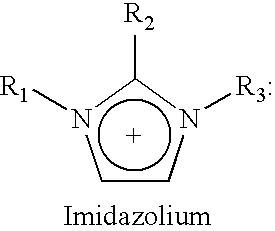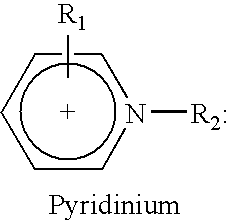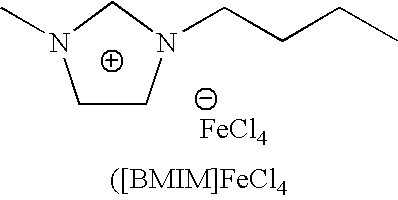Desulfurization of hydrocarbons by ionic liquids and preparation of ionic liquids
a technology of ionic liquids and hydrocarbons, which is applied in the field of synthesis of ionic liquids, to achieve the effects of high efficiency, short time, and high yield
- Summary
- Abstract
- Description
- Claims
- Application Information
AI Technical Summary
Benefits of technology
Problems solved by technology
Method used
Image
Examples
example 1
Synthesis of 1-butyl-3-methylimidazolium Tetrachloroferrate ([BMIM]FeCl4)
[0036]Step 1: In glass reactor, 1.64 g (20 mmol) of 1-methylimidazole was mixed with 5.55 g (60 mmol) of 1-chlorobutane. After 48 hours of stirring and refluxing, the two-phase mixture was formed. The top layer was decanted off. The residue was washed with ethyl acetate (3×20 ml) and vacuum dried at 90° C. for 5 hours. A viscous colorless liquid was obtained (yield 70%)
[0037]Step 2: In glass reactor that is equipped with a magnetic stirring mechanism 0.87 g (5 mmol) of 1-butyl-3-methylimidazolium chloride, obtained from step 1, was introduced and 1.22 g (7.5 mmol) of iron chloride (III) anhydrous was added. The mixture was stirred for 20 minutes at room temperature under an inert atmosphere. A dark red liquid was obtained. The spectroscopic characterizations (1H and 13C NMR) confirm the following chemical structure:
example 2
Synthesis of 1-butyl-2,3-dimethylimidazolium Tetrachloroferrate ([BDMIM]FeCl4)
[0038]Step 1: The 1-butyl-2,3-dimethylimidazolium chloride was obtained (yield 86%) in the same manner described in Example 1 (Step 1) with the exception that 1,2-dimethylimidazole was used instead of 1-methylimidazole.
[0039]Step 2: In glass reactor that is equipped with a magnetic stirring mechanism 0.94 g (5 mmol) of 1-butyl-2,3-dimethylimidazolium chloride was introduced and 1.22 g (7.5 mmol) of iron chloride (III) anhydrous was added. The mixture was stirred for 20 minutes at room temperature under an inert atmosphere. A dark red liquid was obtained.
example 3
Synthesis of 1,3-dibutylimidazolium Tetrachloroferrate ([DBIM]FeCl4)
[0040]This ionic liquid can be obtained by two alternative procedures and using the conventional heating or the microwaves irradiation as the heating source.
Procedure 1
[0041]Step 1: The 1,3-dibutylimidazolium chloride was obtained (yield 90%) in the same manner described in Example 1 (Step 1) with the exception that 2.48 g (20 mmol) of 1butylimidazole was used instead of 1-methylimidazole.
[0042]Step 2: In a glass reactor equipped with a magnetic stirring mechanism 1.08 g (5 mmol) of 1,3-dibutylimidazolium chloride was introduced and 1.22 g (7.5 mmol) of iron chloride (III) anhydrous was added. The mixture was stirred for 20 minutes at room temperature under an inert atmosphere. A dark red liquid was obtained.
Procedure 2
[0043]This procedure consists of three steps.
[0044]Step 1 (Synthesis of 1 (trimethylsilyl)-imidazol): In a reactor 1.36 g (20 mmol) of imidazol and 4.85 g (30 mmol) of 1,1,1,3,3,3-hexamethyldisilazan...
PUM
| Property | Measurement | Unit |
|---|---|---|
| microwave energy | aaaaa | aaaaa |
| atmospheric pressure | aaaaa | aaaaa |
| temperature | aaaaa | aaaaa |
Abstract
Description
Claims
Application Information
 Login to View More
Login to View More - R&D
- Intellectual Property
- Life Sciences
- Materials
- Tech Scout
- Unparalleled Data Quality
- Higher Quality Content
- 60% Fewer Hallucinations
Browse by: Latest US Patents, China's latest patents, Technical Efficacy Thesaurus, Application Domain, Technology Topic, Popular Technical Reports.
© 2025 PatSnap. All rights reserved.Legal|Privacy policy|Modern Slavery Act Transparency Statement|Sitemap|About US| Contact US: help@patsnap.com



